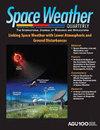Numerical Calculations of Charging Threshold at GEO Altitudes With Two Temperature Non‐Extensive Electrons
IF 3.8
2区 地球科学
Q2 ASTRONOMY & ASTROPHYSICS
Space Weather-The International Journal of Research and Applications
Pub Date : 2023-10-01
DOI:10.1029/2022sw003412
引用次数: 0
Abstract
Abstract Surface charging at geosynchronous altitude is one of the major concerns for satellites and spacecrafts. Spacecraft anomalies are often associated with extreme surface charging events, especially during substorms in which the GEO plasma is better modeled as two temperatures non‐Maxwellian plasma. In such case, we employ two temperature q‐non‐extensive distribution function to determine the onset of spacecraft surface charging which becomes complex since many parameters control the surface charging. We developed a current balance equation which better explains the charging threshold in comparison to a Maxwellian distribution function. The effect of non‐extensive parameters, temperature and density ratio on the current balance equation has been explained. The modified current balance equation predicts the critical and anti‐critical temperatures for various space‐grade materials both analytically and numerically. A significant change is observed in the quantities characterizing the charging current, average yield and density ratio in the presence of non‐extensive two temperature electrons. The mechanism underlying different charging behaviors at or near the threshold is also indicated at various plasma parametric domains. Furthermore, the general conditions of potential jump are also obtained theoretically which predicts the sudden or smooth potential transition.两个温度非扩展电子在GEO高度带电阈值的数值计算
地球同步高度的地面充电是卫星和航天器关注的主要问题之一。航天器的异常通常与极端的表面充电事件有关,特别是在亚暴期间,地球同步轨道等离子体被更好地模拟为两种温度的非麦克斯韦等离子体。在这种情况下,我们采用两个温度q -非扩展分布函数来确定航天器表面充电的开始,由于许多参数控制表面充电,因此变得复杂。我们开发了一个电流平衡方程,与麦克斯韦分布函数相比,它能更好地解释充电阈值。解释了非扩展参数、温度和密度比对电流平衡方程的影响。修正的电流平衡方程用解析和数值方法预测了各种空间级材料的临界和反临界温度。在非广泛双温度电子存在的情况下,在表征充电电流、平均产率和密度比的数量上观察到显著的变化。在不同的等离子体参数域中,还指出了阈值处或阈值附近不同充电行为的机制。此外,还从理论上得到了电势跃迁的一般条件,预测了电势的突然跃迁或平稳跃迁。
本文章由计算机程序翻译,如有差异,请以英文原文为准。
求助全文
约1分钟内获得全文
求助全文
来源期刊
CiteScore
5.90
自引率
29.70%
发文量
166
审稿时长
>12 weeks
期刊介绍:
Space Weather: The International Journal of Research and Applications (SWE) is devoted to understanding and forecasting space weather. The scope of understanding and forecasting includes: origins, propagation and interactions of solar-produced processes within geospace; interactions in Earth’s space-atmosphere interface region produced by disturbances from above and below; influences of cosmic rays on humans, hardware, and signals; and comparisons of these types of interactions and influences with the atmospheres of neighboring planets and Earth’s moon. Manuscripts should emphasize impacts on technical systems including telecommunications, transportation, electric power, satellite navigation, avionics/spacecraft design and operations, human spaceflight, and other systems. Manuscripts that describe models or space environment climatology should clearly state how the results can be applied.

 求助内容:
求助内容: 应助结果提醒方式:
应助结果提醒方式:


